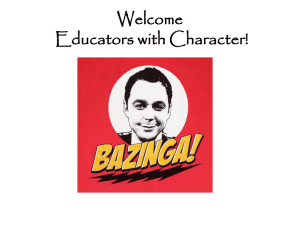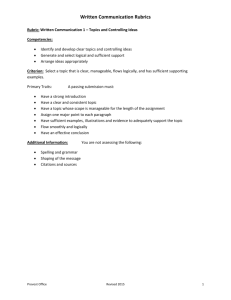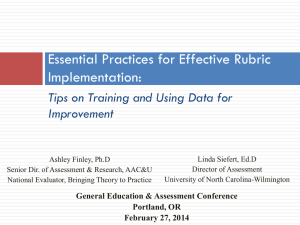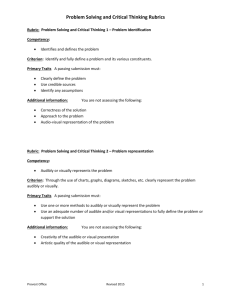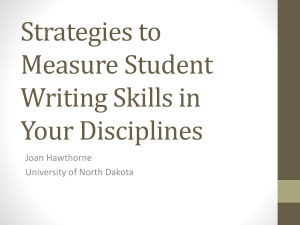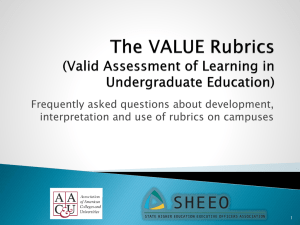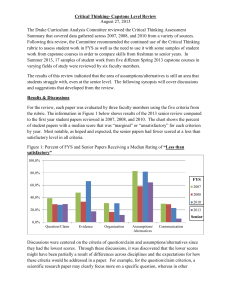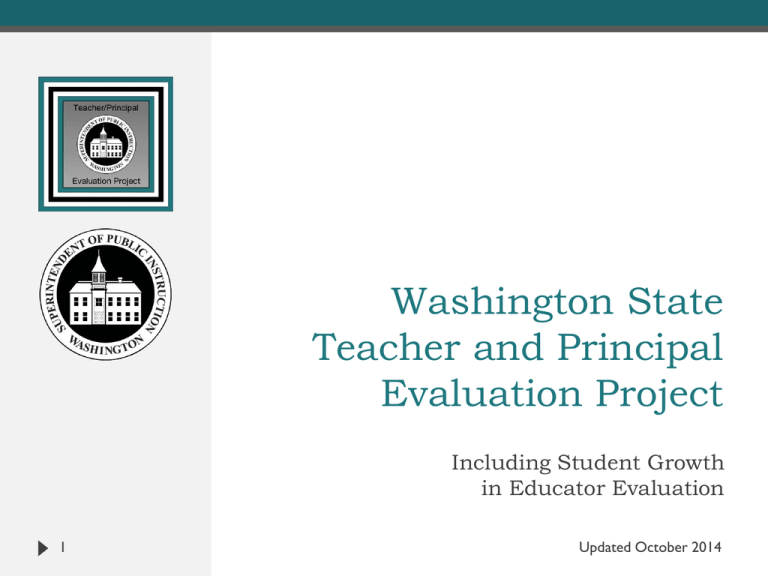
Washington State
Teacher and Principal
Evaluation Project
Including Student Growth
in Educator Evaluation
1
Updated October 2014
Intended Participant Outcomes
Participants will know and be able to:
Understand the legislative requirements for using student
growth data as one of several measures in an educator’s
evaluation in Washington
Understand student growth in focused and comprehensive
formats
Learn and apply the student growth rubric structure and
language
Understand the creation of student growth goals in alignment
with the evaluation criteria
Identify relevant measures of student growth in your district
context
2
Connector: The Visible Learning Story
While you read:
3
What strikes a chord with
you about student growth
(underline)?
What matches where your
district currently stands
with student growth (star)?
What questions does this
raise (question mark)?
Turn and Talk:
Share your thoughts and
questions with a partner
ESSB 5895 Establishes New Definitions
Around Student Growth Measures
RCW 28A.405.100
Changes…
Both E2SSB 6696 and ESSB
5895 contain language around Student growth data must be a
substantial factor in evaluating
student growth, including:
the summative performance of
Student growth data that is
certificated classroom teachers
relevant to the teacher and
for at least three of the
subject matter must be a factor
evaluation criteria.
in the evaluation process and
must be based on multiple
Student growth data elements
measures that can include
may include the teacher’s
classroom-based, school-based,
performance as a member of a
district-based, and state-based
grade-level, subject matter, or
tools. Student growth means
other instructional team within
a school when the use of this
the change in student
data is relevant and
achievement between two
appropriate.
points in time.
4
Defining Key Terms
Student Achievement: The status of subject-matter
knowledge, skills, understanding or performance a given
point in time.
Student Growth (Learning): The change in student
achievement between two points in time.
It is student growth, not student achievement,
that is relevant in demonstrating impacts
teachers and principals have on students.
5
Student Growth Rubrics
RCW 28A.405.100
The TPEP steering committee organizations approved
statewide rubrics for student growth to ensure
consistency in implementation of the evaluation system
across Washington State.
The rubrics for student growth describe both goal setting and
outputs of student learning.
OSPI has provided student growth rubrics for all
educators:
6
Teachers: 3, 6, and 8
Principals: 3, 5, and 8
Student Growth Goals
Goals measure “a change
in student achievement
between two points in
time” RCW28A.405.100
AND
Focus on significant
content within the scope
of the teacher’s
responsibility
7
Growth is expected for all
students
Evidence of growth
derives from more than
one of these multiple
measures…
Classroom-based
tools
School-based tools
District-based tools
State-based tools
Using District, School, and
Classroom-Based Data (Teachers)
RCW 28A.405.100
Five Student Growth Criteria
3.1 Establish Student Growth Goals
Re: individual or subgroups of students (achievement/opportunity gap)
3.2 Achievement of Student Growth Goals
Re: individual or subgroups of students (achievement/opportunity gap)
6.1Establish Student Growth Goals using Multiple Student
Data Elements
Re: whole class based on grade-level standards and aligned to school and
district goals
6.2 Achievement of Student Growth Goals
Re: whole class based on grade-level standards and aligned to school and
district goals
8.1 Establish Team Student Growth Goals
Re: Teacher as part of a grade-level, content area, or other school/district team
8
The Student Growth Rubric
9
RCW 28A.405.100
Learning Activity: Unpacking the
Student Growth Rubric
Individually:
Read across the rows and highlight
the key descriptions of
performance at each level.
Look down the column and circle
the key words or ideas that best
summarize each of the four
performance levels.
As a table group/district team
answer these questions and create
3 charts:
10
What are the key differences
between proficient and distinguished?
Between proficient and basic?
Between basic and unsatisfactory?
What does a teacher need
to know, say, and do to
demonstrate proficiency on
these rubrics? Create a chart
for each criterion.
Criterion ___
Debrief
Each team names for the large group a key characteristic
of the student growth rubric – either in terms of a
performance level description or in terms of the key
actions needed by teachers.
Each team names one thing that teachers need to know,
say, or do to demonstrate proficiency on the student
growth rubric.
11
Alignment Considerations
Assessments should cover key subject and grade-level
content standards.
No items, questions, or prompts should cover standards
that the course does not address.
The assessment structure should mirror the distribution
of teaching time devoted to course content.
The cognitive demands of the assessment should match
the full range of cognitive thinking required during the
course.
12
The Data Pyramid: What Kind of Data
Do Teachers Use? How Often?
Summative
2-3-4 times a year
Regularly during the year
Daily or weekly
Formative
Practices
Adapted from N. Love, K. E. Stiles, S. Mundry, and K. DiRanna, The Data Coach’s Guide to Improving Learning for All
Students: Unleashing the Power of Collaborative Inquiry, Thousand Oaks, CA: Corwin, 2008. All rights reserved.
13
Learning Activity IV: Creating Your Own
Data Pyramid for Your District
Annually
2-4 times
a year
Quarterly or
end of unit
1-4 times
a month
Daily/
weekly
14
Example: A Washington Data Pyramid
Annually
2-4 times
a year
Quarterly or
end of unit
1-4 times
a month
Daily/
weekly
15
End of course exam (EOC),
MSP, ACT, SAT, ASVAB,
PSAT, IB tests, AP tests,
WELPA (ELL), district finals
Benchmark assessments, MAP
(Measure of Academic Process),
DIBELS, CBAs, music performances,)
finals/mid-terms, common
assessments, RBA (ELA), fit-n-fun day
Unit test, project/exam = summative demonstration,
practice MSP portfolio, grade-level common
assessments, oral exams, skills performance test,
collaborative with classroom teachers - 6 trait writing:
transferable learning, PB exams, RCBM,
Performance tasks
Unit test/project, common formative assessment, essays
(all content areas), literature circles, writing groups presentation and
projects with rubric criteria, peer assessments, quizzes, writing samples,
student self assessment, timed writing probes, weekly math-fact fluency,
writers workshop writing samples, AIMS (reading/math assessment),
running records
Entry/exit slips, quiz, homework, quick checks, focus task, summary task, think-pair-share,
student reflection, note check, student dialogue/discourse/demonstration, student white
boards, conferring with students, diagram labeled with words (ELL), student interviews,
hand votes, written responses, science lab, math practice
Establishing Targets
Identify the expected outcomes by the end of the
instructional period for the whole class (criterion 6)
or for subgroups (criterion 3), as appropriate.
Criterion 3:
Subgroup of
students not
meeting full
learning
potential.
High evidence of learning for
all/nearly students
Target would be:
Clear evidence of learning for
most students
(Achievement
Target would be:
Gap)
16
Evaluating Goals for Criterion SG 3.1
Review of the Learning Goal (s)
Use the following protocol to
confirm that the Learning
Goal has the right size, detail,
and depth necessary.
(proficient level language is
used, please see the critical
attributes resource for
additional levels of
performance)
Check the boxes that apply.
17
The Learning Goal:
Identifies subgroups and uses data that identifies students not
reaching full learning potential (i.e. achievement/opportunity gaps,
ELL, special education, highly capable)*
is specific, measureable and time-bound
is based on multiple sources of available data that reveal prior
student learning
is aligned to content standards
is appropriate for the context, instructional interval and content
standard(s) (grain size)
demonstrates a significant impact on student learning of content
(transferable skills)
Identifies formative and summative measures aligned to learning
targets to monitor progress towards goals
Learning Activity: Creating Growth
Goals
With a partner or two, spend 20 minutes creating
examples of student growth goals:
one in your content area and grade level
one outside your area of content expertise
one that you would hope a teacher one grade below
would write for students to prepare them for your class
Pick one to share
18
Debrief
Gallery Walk: Review the goals from each group
Debrief
19
Was this brief experience harder or easier than you expected?
How might you use this activity with groups of educators in
your district?
How might you modify this activity?
Evaluating Criterion SG 3.2
Student growth criterion 3.2: Make a student learning claim and provide evidence
for the actual outcomes at the end of the instructional period for subgroups not
meeting full learning potential.
Teacher completes the section below.
Make a rating claim
as to the level of the
actual outcomes
based on the goals
for student learning.
Claim
High evidence of learning for all/nearly all students (Distinguished)
Clear evidence of learning for most students (Proficient)
Some evidence of learning for some students (Basic)
No evidence of learning for most students (Unsatisfactory)
Please provide student learning evidence from at least two points in time that
supports your claim of student learning (2 or more sources):
20
21
22
Thank you!
Presenter Name
xxxxxxxxxxx@xxx.xxx
23

